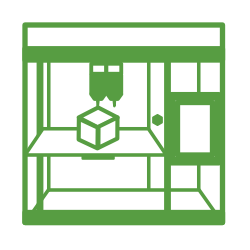About
The Technology Lab has twelve 3D printers that are exclusively dedicated to the service of active UTSOA students and faculty. Use of the 3D printers requires a current Digital Fabrication Subscription. To use them, simply e-mail two things to the Technology Desk: your correctly prepared file and proof that your file has been repaired in Netfabb. Information about how to prepare this type of file, and where and how to perform the Netfabb test can be found in the links below. Once you've approved the cost estimate, you're all set! The Tech Desk staff will follow up with you via email when your 3D print is ready for pick up.
All 3D prints are created with either PLA (Raise3D) or ABS plastic (Stratasys). Students may not substitute their own materials. Orthogonal features finer than 1/8" are too small to be accurately produced by the printer and will result in a less desirable final product – especially when soluble support material isn't used. Complex geometries must be larger than 1/8" to print successfully. The maximum size of your print is limited by the interior capacity of the individual printer.

This was printed on a Stratasys 3D printer using ABS model material and soluble support material. The small features were made possible by the use of soluble support material.
Raise3D
The Raise3D Printers use PLA filament. Our models have different maximum volumes. If your model requires supports to be generated, the Raise3D printers will use PLA. You must remove the support structures after you receive your final print.
- Pro3
- Single Extruder Print: 11.8" x 11.8" x 11.8"
- Dual Extruder Print: 10" x 11.8" x 11.8"
- Pro3+
- Single Extruder Print: 11.8" x 11.8" x 23.8"
- Dual Extruder Print: 10" x 11.8" x 23.8"
Stratasys
The Stratasys Printers use ABS (model) and QSR (soluble support). If your model requires supports to be generated, the Stratasys printers will use QSR. We will run your print through a chemical wash process to remove the QSR before you receive it.
- F370
- Build volume 14" x 10" x 14"
3D Printing Costs & Estimates
A price estimate will be provided for you after submission as time allows us to complete our internal processes. If you do not pick up your print, you will still be charged the full amount to your What I Owe.
| Raise3D | Material | Cost per Gram |
|---|
| PLA Model | $0.05 |
|---|
| PVA+ Support* | $0.20 |
|---|
| Stratasys | Material | Cost per Cubic Inch |
|---|
| ABS Model | $2.50 |
|---|
| QSR Support | $5.00 |
|---|
*We're not using this material yet, so any support structures within your Raise3D prints will use PLA.
Time Expectations
Prints can take anywhere from several hours to several days depending on size and complexity. During periods of high volume, the queue may delay your print by several days. Please keep this in mind when considering due dates.
Best Practices
Resources
In addition to the 3D Printing capabilities provided in the SOA, here are some external resources for 3D Printing:

